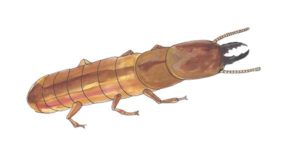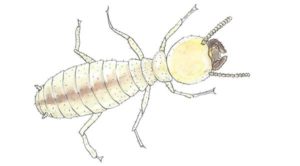We know everything there is to know about drywood termites, including their physical characteristics and behavior. We can help you identify when you have drywood termites in your home and we will help you to get rid of them. For more information about drywood termites, please visit our Pest Identification Library.
Physical Characteristics
Drywood Termite Swarmer

- Body averages 7/16 inches in length including wings.
- Head & body is orange/brown
- Abdomen is dark brown
- Wings are shiny and iridescent
Drywood Termite Soldier

- Body averages 5/16 inches in length.
- Body is reddish brown to orange
- Black mandibles on front end used for defense
Drywood Termite Worker

- Pale to white body
- Round head with straight antennae
- Do not appear to have eyes
Behavior
Drywood termites do not require moisture or contact with the soil, therefore they create their colony inside the wood in homes. A drywood termite colony can consist of hundreds to thousands of wood destroying termites. In our area of Florida, drywood termites typically swarm between May and July. Swarming drywood termites are often discovered on windowsills because they swarm at night and are attracted to the light illuminating from windows.
Signs of a Drywood Termite Infestation
- Swarms
When a drywood termite colony is mature, swarms of winged male and female reproductive termites emerge from the nest. These reproductive termites fly out of their colony to create new colonies through mating. - Fecal Pellets or “Frass”
Drywood termites extract as much water as possible from the feces to conserve it. The result is very distinct fecal pellets known as “frass.” They are a hexagonal and all are a similar size of 1mm long. The termites kick them out of their tunnel in order to clean the nest. Appearance of pellet mounds indicates termite activity. It is important to note that pellets can remain almost indefinitely from a dead colony and may mislead a homeowner that it is current activity. - Damage
Drywood termites eat across the grain of wood and create smooth galleries or tunnels inside their colony. Drywood termites will leave behind a thin layer of wood, eating to just before the surface. Using a screwdriver to jab the wood will reveal hidden termite colonies inside the home.
Treatment for Drywood Termites
Currently, there are two treatments most commonly used to control drywood termites – spot treatment and tent fumigation. Many concepts such as heat, wood replacement and microwaves have come and gone. Carefully educate yourself on the difference between the two treatments so you can make the best decision for your home.
